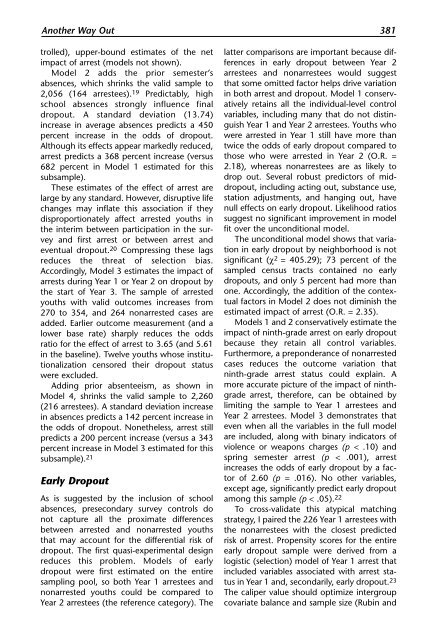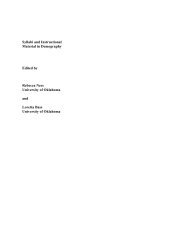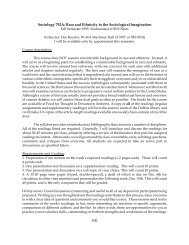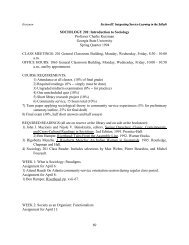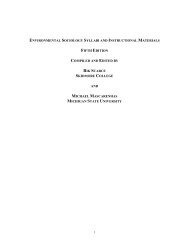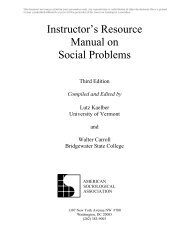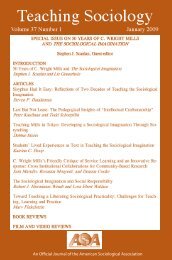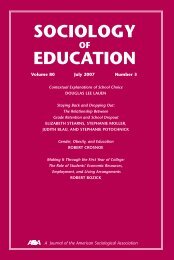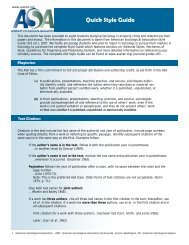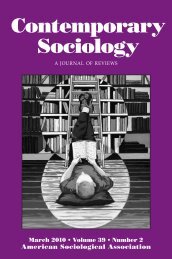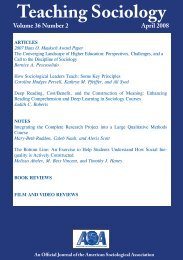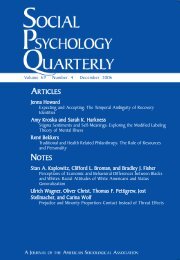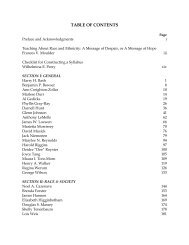SOCIOLOGY EDUCATION - American Sociological Association
SOCIOLOGY EDUCATION - American Sociological Association
SOCIOLOGY EDUCATION - American Sociological Association
Create successful ePaper yourself
Turn your PDF publications into a flip-book with our unique Google optimized e-Paper software.
Another Way Out 381<br />
trolled), upper-bound estimates of the net<br />
impact of arrest (models not shown).<br />
Model 2 adds the prior semester’s<br />
absences, which shrinks the valid sample to<br />
2,056 (164 arrestees). 19 Predictably, high<br />
school absences strongly influence final<br />
dropout. A standard deviation (13.74)<br />
increase in average absences predicts a 450<br />
percent increase in the odds of dropout.<br />
Although its effects appear markedly reduced,<br />
arrest predicts a 368 percent increase (versus<br />
682 percent in Model 1 estimated for this<br />
subsample).<br />
These estimates of the effect of arrest are<br />
large by any standard. However, disruptive life<br />
changes may inflate this association if they<br />
disproportionately affect arrested youths in<br />
the interim between participation in the survey<br />
and first arrest or between arrest and<br />
eventual dropout. 20 Compressing these lags<br />
reduces the threat of selection bias.<br />
Accordingly, Model 3 estimates the impact of<br />
arrests during Year 1 or Year 2 on dropout by<br />
the start of Year 3. The sample of arrested<br />
youths with valid outcomes increases from<br />
270 to 354, and 264 nonarrested cases are<br />
added. Earlier outcome measurement (and a<br />
lower base rate) sharply reduces the odds<br />
ratio for the effect of arrest to 3.65 (and 5.61<br />
in the baseline). Twelve youths whose institutionalization<br />
censored their dropout status<br />
were excluded.<br />
Adding prior absenteeism, as shown in<br />
Model 4, shrinks the valid sample to 2,260<br />
(216 arrestees). A standard deviation increase<br />
in absences predicts a 142 percent increase in<br />
the odds of dropout. Nonetheless, arrest still<br />
predicts a 200 percent increase (versus a 343<br />
percent increase in Model 3 estimated for this<br />
subsample). 21<br />
Early Dropout<br />
As is suggested by the inclusion of school<br />
absences, presecondary survey controls do<br />
not capture all the proximate differences<br />
between arrested and nonarrested youths<br />
that may account for the differential risk of<br />
dropout. The first quasi-experimental design<br />
reduces this problem. Models of early<br />
dropout were first estimated on the entire<br />
sampling pool, so both Year 1 arrestees and<br />
nonarrested youths could be compared to<br />
Year 2 arrestees (the reference category). The<br />
latter comparisons are important because differences<br />
in early dropout between Year 2<br />
arrestees and nonarrestees would suggest<br />
that some omitted factor helps drive variation<br />
in both arrest and dropout. Model 1 conservatively<br />
retains all the individual-level control<br />
variables, including many that do not distinguish<br />
Year 1 and Year 2 arrestees. Youths who<br />
were arrested in Year 1 still have more than<br />
twice the odds of early dropout compared to<br />
those who were arrested in Year 2 (O.R. =<br />
2.18), whereas nonarrestees are as likely to<br />
drop out. Several robust predictors of middropout,<br />
including acting out, substance use,<br />
station adjustments, and hanging out, have<br />
null effects on early dropout. Likelihood ratios<br />
suggest no significant improvement in model<br />
fit over the unconditional model.<br />
The unconditional model shows that variation<br />
in early dropout by neighborhood is not<br />
significant (χ 2 = 405.29); 73 percent of the<br />
sampled census tracts contained no early<br />
dropouts, and only 5 percent had more than<br />
one. Accordingly, the addition of the contextual<br />
factors in Model 2 does not diminish the<br />
estimated impact of arrest (O.R. = 2.35).<br />
Models 1 and 2 conservatively estimate the<br />
impact of ninth-grade arrest on early dropout<br />
because they retain all control variables.<br />
Furthermore, a preponderance of nonarrested<br />
cases reduces the outcome variation that<br />
ninth-grade arrest status could explain. A<br />
more accurate picture of the impact of ninthgrade<br />
arrest, therefore, can be obtained by<br />
limiting the sample to Year 1 arrestees and<br />
Year 2 arrestees. Model 3 demonstrates that<br />
even when all the variables in the full model<br />
are included, along with binary indicators of<br />
violence or weapons charges (p < .10) and<br />
spring semester arrest (p < .001), arrest<br />
increases the odds of early dropout by a factor<br />
of 2.60 (p = .016). No other variables,<br />
except age, significantly predict early dropout<br />
among this sample (p < .05). 22<br />
To cross-validate this atypical matching<br />
strategy, I paired the 226 Year 1 arrestees with<br />
the nonarrestees with the closest predicted<br />
risk of arrest. Propensity scores for the entire<br />
early dropout sample were derived from a<br />
logistic (selection) model of Year 1 arrest that<br />
included variables associated with arrest status<br />
in Year 1 and, secondarily, early dropout. 23<br />
The caliper value should optimize intergroup<br />
covariate balance and sample size (Rubin and


